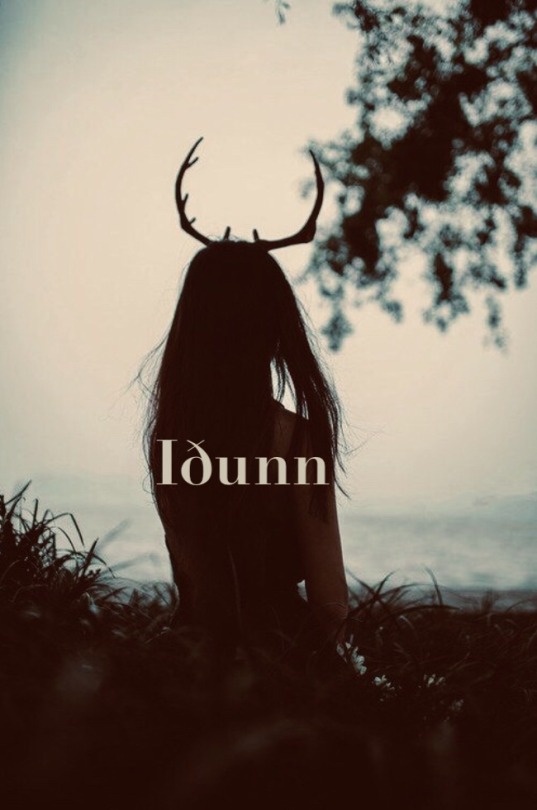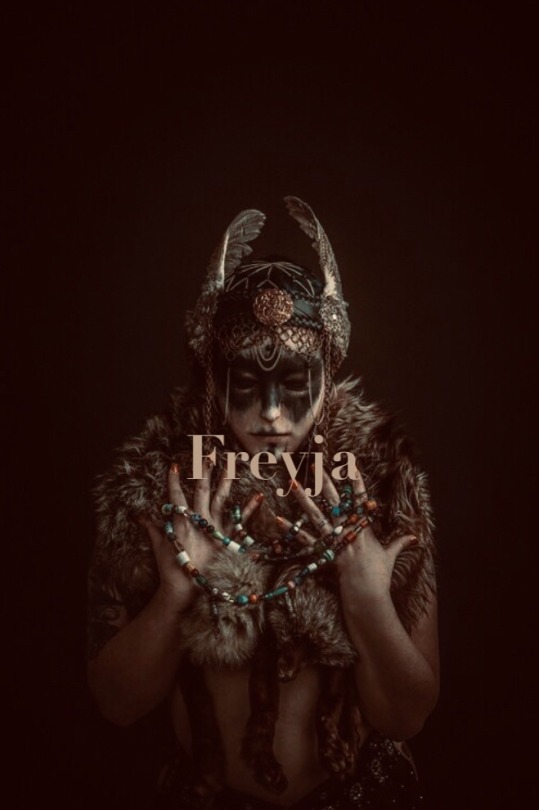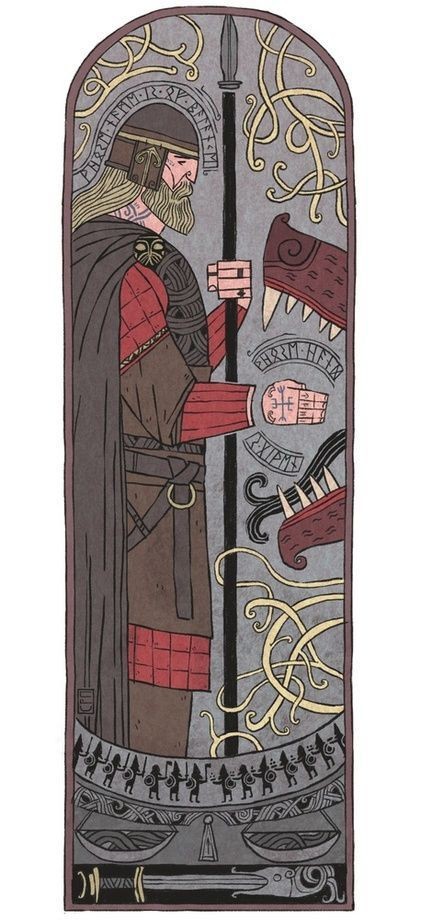27 Nonbinary he/him Pagan and Satanist Explores the goetia and German neo paganism Speaks fluent English, German Vegetarian Nazis and racists get fucked, assholes!
Last active 60 minutes ago
Don't wanna be here? Send us removal request.
Text
The Witch Father

In traditional witchcraft, we often come across mentions of the enigmatic Witch Father. His Folklore is scattered, and there is little consensus to who He is. The mythology of Witch Father folklore is spread across centuries, hidden in tales of the Devil and in the transcripts from witch trials. He is a multifaceted being who rules over life, death, initiations, knowledge, and the untamed wilderness lurking at the edges of society.
The Witch Father is an archetypal Divine Masculine Spirit that illuminates life and is a lord of death. Witch Father is a catchall title for the myriad spirits witches have historically contracted with and have since been omitted by the witch trial transcripts across Europe.
He is most commonly known as the Devil in today’s craft. As we know him, The Witch Father is an initiator and holds the keys to our disinhibition towards pleasure. He opens the way to occult knowledge and gives us the opportunity to explore (legal) pleasures without the need for guild or shame. Walking with the Witch Father allows us to dive into the hidden realms and learn the Occult Arts to change our lives. He also allows us to revel in primal human desires.
As the Initiator into Witchcraft, the Witch Father takes on the mantle of the Light Betwixt the Horns. He comes into our lives and offers us the choice to go down this path and walk with Him. He grants us an understanding of magick, nature, and pleasure. He empowers us to uncover our Truth and the Truth of the World. As the initiator, some see the Witch Father as Lucifer. He is also the Serpent who revealed to Eve that the fruit from the Tree of Life will not cause her to die but will grant the wisdom of the universe.
The Witch Father allows space for us to free ourselves from the inhibitions placed on us by general society, and especially the church. He encourages us to rebel, sing, dance, and uncover wisdom. He leads the Witch’s Sabbath, which grants us a place to revel in the freedoms offered there. By leading us to this sacred experience, He fills his role as an emanation of the untamed wilderness, the primal subconscious of our most human desires. He gives us the Church of Nature. Taking the liturgical prayers of the Church and the Book of Psalms, mixing that with more ancient pagan animism, we are given access to a hidden power through His teachings.

Now, while I talk as if the Witch Father is a God, he is not. He is an ancient and powerful spirit who has led witches over the centuries and demands reverence. He is not all-powerful and is not a creator. He works his charms through magic and shapes the world. He is not a distant, impersonal being. He is immediate to us and is a mentor for us.
Disinhibition
At the Witch’s Sabbat, our spirits fly away to commune with Our Devil, other witches and spirits in His retinue. It was a place to mix business and pleasure. At the Sabbat, witches would learn new spells, come together to work rituals, learn new forms of magick from the Witch Father, and of course partake in enjoyment.
The Sabbath is a place of Initiation for new witches and also a place for learning new aspects of the craft. Once the business concludes, the Sabbat becomes a celebration. We may forget the staunch rules of mundane society and revel in our animalistic and beastial joys. There is singing, dancing, food and drink. We can indulge in these desires and these delicacies. All of which is orchestrated and gifted to us by the Witch Father.
The Wild
There is a deep connection between the Witch Father and Nature. They are ��synonymous with each other. He is an emanation of the land and its spirits. As Christianity became the dominant religion, and as society shifted further away from living in harmony with Nature, the figure of the folkloric Devil grew. He calls to us to return to the untamed lands and to forget the society that weighs us down. He offers liberation instead of our oppression.
The Witch Father, as Nature, holds a duality over life and death. He is life itself and the bringer of light. But he is also the Lord of Death and of shadows. As the year turns, we see both aspects and the cyclical nature of them. Death giving way to new life and of life giving way to death. He is destruction and creation. Death and resurrection.
Even His iconography and the existing descriptions that we have of the Devil show the immense connection He has to the Land. He is a shapeshifter comfortable in being a recognizable animal, a humanoid form, or even a hybrid. He reminds us of our baser instincts and that we are not above animals or the land just because we, as humans, have subjugated them for centuries.
He is the Horned one, the light betwixt the horns, Terra Pater, Primus Magus. And he has revealed himself to us in so many other forms throughout the centuries. It’s hard to pigeonhole the Witch Father as any one being, or to even say “this is what he looks like.” He’s shown us he is comfortable changing his shape on a whim. He takes on the mantles of mentor, guide, and is a safe space for us to let our guard down and find enjoyment outside of our mundane lives.
Old Scratch
Old Scratch is a more antiquated term for The Devil or Satan primarily found in the Southern United States and the South Midlands. This name has been memorialized in Faustian Folklore such as “The Devil and Tom Walker” and “The Devil and Daniel Webster” where our protagonist sells his soul to the devil for prosperity.
This reinforces the theme that our Witch Father, the Folkloric Devil, offers us a chance to change our luck and our lives. Now, in these stories, the protagonist is taken away and dragged into the fires of hell, but in the living practice of Traditional Witchcraft, it doesn’t happen that way. We see these stories as what happens when trying to break deals with the Otherworld. Contracts and Pacts made with Spirits should be kept up with. It’s imperative.
Black Shuck
In East Anglian folklore, Black Shuck is an omen of death. If you see him, it is said that you will die before the year is up, and if you meet his eye you’ll be dragged away.
The first mention of the Black Shuck is in “The Anglo-Saxon Chronicle” in 1127 where He is affiliated with a Wild Hunt that was in Petersborough from Lent through Easter. Later on, in the 1500s, he is said to have broken into a church and killed two paritioners while kneeling in prayer.
Here we see the Chthonic side of the Devil. He is a psychopomp taking souls to the Other Side. He is a shepherd of the dead, warns us of impending doom, and teaches us about life, death, and ways to travel between the Worlds.
643 notes
·
View notes
Text

✨️🪷Blessed Ostara🪷✨️
We in the Northern Hemisphere are celebrating the Spring Equinox today.
Here's a few ways to celebrate.
•Clean & Cleanse
your home and sacred spaces hold energy, especially altars. Give them a refresh today. Add pastel colors, stones, and candles to correlate with spring. Pack up that winter gear & heavy long sleeves.
•Plant Seeds
whether you're starting your garden or making solid plans for your future, today is a great day to start. Got a garden? Start cleaning and prepping, sowing magic for abundance!
•Sun Soak
the sun is back, and the darker days are becoming a thing of the past! If it's nice in your area, go outside and soak up that sunshine. Open some windows, bring in fresh air and that fresh start!
•Herbal Bath
throw some dried herbs and Epsom salt into a warm bath, wash away your winter blues! Add drops of essential oils or your favorite bubble bath & enjoy.
There are so many other ways to celebrate today, but do what feels best for you!
Happy Casting ✨️
-Grunge
424 notes
·
View notes
Text
Fun and easy habits to develop as a pagan!

Or, a few ideas of routine pagan stuff I personally engage in, or wish to start engaging in.
Opening the curtains and taking a quick moment to appreciate the daylight (or the darkness) of the outside. Draw from it the energy you will need for the day!
After waking up, saying a short prayer to a deity of your choice (you could very well change it up based on your intent, or always pray to the same if you are devoted to one in particular). A simple “Good morning. I will try to honor you today” shows that you’re thinking of them!
Taking a little time every once in a while to learn about local plants, trees or fauna! Little by little, you’ll learn to recognize them when out in nature. Nothing more rewarding!
Playing a song, or simply instrumental music that reminds you of your spirituality when doing chores, preparing for the day or the night, etc. Useful if the day-to-day makes you feel disconnected from your spirituality!
Every once in a while, cleansing a spiritual space by simply cleaning it out before lighting a fragant candle or incense. Always makes me feel refreshed!
Focusing on a picture of a deity/deities (or spirit/spirits, or ancestor/ancestors) of your choice in adoration. What can they teach you today? How can you honor them?
Diffuse a smell (either by candle, incense, essential oil diffuser or else) while getting prepared for the day! If such a topic interests you, you could learn about how different smells affect us, and how you can use that in this specific ritual. With what intent do you wish to start your day?
If you have a book/books on mythology that pertains to your deity/deities or their related culture, why not read a few pages every once in a while, just for fun! Like the song/music I mentioned before, this an easy way to start your day thinking of your spirituality.
Looking up art: depictions of deities, or if you worship nature spirits, pictures of the animal or plant the form of which it takes.
Adopting a deity’s symbol for the day! You can do that by wearing a piece of devotional jewelry, or even drawing a rune/sigil/symbol on your skin so as to keep the deity in mind.
If you’re reading this, it means you use tumblr! Why not use such social networks to talk to other pagans who share your practices? There’s lots to learn from each other! Plus, you may make good friends this way.
Look outside, observe the weather. What color’s the sky? How strong is the wind blowing? In what direction are the clouds being blown? Stay in tune with nature! You may even become able to tell which signs foretell which weather events!
Make stuff you find in nature into amulets. For example, if a leaf, rock, acorn, fallen branch or else catches your attention, why not bring it home as a lucky charm? If you possess such a skill, you could even make it into jewelry!

2K notes
·
View notes
Text
some reminders from Odin:
• Don't run your mouth 24/7, shut up and just listen.
• Do not get carried away with alcohol, it can turn a wise man into a fool very fast.
• Reciprocate the nice things your friends do for you.
• Do not feel ashamed if you are lacking more than others. All one needs is clothes on their back and a roof over their head.
• Find happiness in yourself and do not rely on others for this happiness.
(all from the Hávamál)
[ If you use any of the Poetic/Prose Edda to justify your racism or bigotry gtfo btw ]
2K notes
·
View notes
Text
Gods of Death
Hel and Odin
It has been a while since I have posted something, but I have been doing a lot of reading and thinking, particularly about death. In this blog I want to look at Hel and Odin, who share some traits as gods who collect the dead, but who seem to be working in opposition to each other. Hel is an outsider just like her parent Loki. She is a jötunn (“giant, glutton, overeater”) born in Jotunheim, and a force of chaos and destruction, as opposed to the Aesir/Vanir, who mainly seem to be forces of creation and order. Odin, as god of war, however, does not shy away from causing a little chaos and destruction, but then, Odin is also of jötunn parentage.
Hel is described by Snorri as being half a corpse, monstrous like her siblings Fenrir, the giant wolf, and Jormungand, the giant serpent, but unlike them she takes a human form. The gods receive a prophecy (Prose Edda, Gylfaginning) concerning Loki’s monstrous offspring, and Odin has them brought from Jotunheim to Asgard. Jormungand is thrown into the sea, Hel is made ruler of the underworld, but Fenrir is fostered in Asgard. Why does Fenrir get this treatment? Perhaps simply because Odin likes wolves (he already has two pet wolves, Geri and Freki), or perhaps because he thinks the wolf will be an asset to him, as his dead warriors in Valhalla are. Hel is not given a place at Asgard, and she seems to be as much a prisoner of the underworld as she is its ruler, which to me suggests that the other gods see Hel as a danger to them. I think Hel embodies death or death of the gods. She is a harbinger of doom, and omen of Ragnarök. She is the daughter of Loki, after all, and Angrboda (“harm-bidder”, “bringer-of-sorrow”). What with Hel being half a corpse, she is a visible reminder of that which we will all one day become. The Norse gods are not immortal, and I think especially Odin is afraid of death and/or losing his mind, which would mean losing all the knowledge and experience he has gained (in Gylfaginning he says he is afraid of Huginn and Muninn not returning to him). On his wanderings, Odin queries spirits and jötunns about the afterlife and his own and his son’s demise. Is Odin trying to cheat death or to put it off as long as possible? He lets people who have died live on in his hall. These people make up his army that he will use to fight against the forces of death/chaos at Ragnarök. Hel could be a personification of death coming to stop Odin before he discovers the secret to not dying.
Before they are brought to Asgard, Hel and her brothers never harmed the gods, so by taking them from their home and banishing and chaining them, do they not have a hand in fulfilling the prophecy? If Hel is death, she cannot be killed, only temporarily ignored or warded off. Is this why the best thing Odin can do is to make her ruler of the underworld? She does not die and disappear there, but it seems she cannot leave either. She can still influence the other realms, though her influence only extends to taking in the shades of those who have died of old age and sickness.
What is this place Hel is made ruler of? The sources contradict each other. According to some, it is located under Niflheim (“Place of Mists”). In Baldur’s Dreams in the Poetic Edda, Hel is described as being located in Niflhel. In another tale it is said to be located under one of the roots of Yggdrasil, the world tree. In any case, Hel in Old Norse means ‘hidden’, so Helheim = Hidden Place. It seems fitting that there is no conclusive answer as to where it is, because it is not for us living people to know.
Niflheim is said to have existed before anything else did. It is a cold, dark and misty place, but it is not a void, it has material, it has rivers. The water running out of Niflheim turns to ice and fills up the Void (water = a source of life). It makes sense to me, therefore, that this is the sort of primordial place where people return to after they die to become material once again. When we think of someone dying, we picture them going somewhere else, but if, like me, you do not believe in any sort of afterlife, they are in fact not going anywhere. Still, they are no longer Here with us, we can’t see them or talk to them, and since Nowhere At All is kind of hard to imagine, we assume they must be Somewhere Else.
It seems to me that Folkvang, Freyja’s meadow where she receives half of those who have died in battle, and Valhalla are just temporary stops on the way to Somewhere Else (a.k.a. Hel, the Hidden Place). Valhalla in particular sounds like some terrible limbo, a Groundhog Day/Russian Doll kind of time loop, where the fallen warriors eat, drink, fight, die and rise again the next day to repeat the same process, until the inevitable end, Ragnarök, comes. Odin keeps his guests in a state of intoxicated forgetfulness.
Like Odin, Hel has an army of dead people, but unlike him she does not seem to have amassed it on purpose. She lends the dead people to her parent Loki, who captains this army at Ragnarök. Perhaps she wasn’t too happy about the fact that she and her brothers were kidnapped and then banished/locked up. Additionally, I think her function is to end everything so the cycle can begin again. Odin and the others need to make way for the next generation of gods.
If gods die, then, do they also go to Niflheim/Niflhel/Hel? It does appear to be the case. A feast is prepared in Hel for Baldur, and he goes there after he is killed by the mistletoe dart. He does not die in battle, but his death is an accident. Niflheim/Niflhel/Hel seems to be a place where ordinary people go, and where there is calm and rest. Snorri calls the being Hel cold, and uncaring about the fate of humankind, but that is just what a mortal person would say about death, isn’t it? Yes, death sometimes may seem cruel and unjust, but I suppose there is equality in death, and as Neil Gaiman wrote, we all get what everybody gets: a lifetime. Hel treats everybody the same, regardless of the life they have lived. They do not have to die honourably or prove themselves in battle to be granted entry to her realm. She also ends the suffering of those who are old and sick. As distressing as it may be to us, life cannot exist without death. There are different motives that can be attributed to Odin and his thirst for knowledge. It could be a fear of death, wanting to stop the prophecies about Ragnarök becoming true, or a desire to make the most of his time in the face of his inevitable demise, or a bit of both. A relatable guy. I want to end this blog with a quote from Sayings of the High One: “Cheerful and merry every man should be, until he comes to death."
110 notes
·
View notes
Text
Carromancy Interpretations and Meanings
Carromancy is the art of scrying or divining through melted wax. Pouring the candle wax into a water basin to see the shapes it makes can be Carromancy as well, but it's often referred to as "Ceromancy"

Clean Burning Candle Wax
A candle that burns all the wax is fairly rare. There is usually some type of wax residue with almost every candle spell cast. If your candle has a clean burn, then you've been given the rare wholehearted approval of the spirit world and your spell is a success.
Clockwise Candle Wax Flow
The clockwise candle wax flow is a positive sign that you are attracting something to you. If you cast a spell to bring something to you or to the object of your spell, then this is a sign that your spell was successful.
Counterclockwise Candle Wax Flow
A counterclockwise candle wax flow means that something is moving away from you or the object of your spell. If you cast a spell to attract something to you or an object, then this wax flow indicates the timing for your spell isn't right. However, if you cast a reversal or uncrossing spell, this would indicate that your spell worked.
Cascade Flow of Candle Wax Layers
If the candle wax cascades down the candle in a flow that overlaps like a step down or waterfall appearance, you can read the wax as an indicator of change. If your spell is to usher in change, this is a good sign. The changes are backed by powerful energies that topple onto each other as the force pushes forward.
Candle Wax Backflow Meanings
There are several ways to interpret the backflow of candle wax. A backflow is created when the melted wax begins to form a shape, but the wax flows away as though changing its mind. The wax leaves a unique hollow shape that resembles a shallow pool that has been drained of the wax. When you see a backflow form, it indicates a reversal of circumstances or events.
A few examples include: Someone has broken their promise or commitment. It might indicate that an agreed business deal won't go through. If it is a personal commitment like an engagement, the reading indicates the person won't follow through. If it is a legal appeal, then it indicates the new ruling will undo the previous one.
Curling Wax
Sometimes a candle will burn in such a way that one side of the candle falls over and curls onto itself. This often looks like a petal on a flower or an ocean wave. The wax curling indicates a form of inattention that is ignorant of your desires or wishes. It can also indicate the object of your spell is bending over backwards to comply with your wishes or desires. The curling signifies your will slowly overpowering that of another person, situation, or circumstances.
Candle Wax Floodings
The overflow of wax can create a flood of wax that rushes over the candle holder. If you experience this type of wax flooding, it indicates the results of your spell will have a greater impact than anticipated. It demonstrates that the candle was unable to contain the power behind your spell and the force it gathered in its manifestation.
A candle wax flood can be characterized as out-of-control. You must examine the intention of your spell to assess how this flooding of wax will impact the desired results. For example, if your spell is career related, then there will be a greater result that may prove to be overwhelming and unexpected. It will knock you off-center. If it is a love spell, you may be completely swept off your feet and carried away with emotions.
Partial Burn
If your candle doesn't burn evenly and part of the candle remains standing like a partial wall, it usually reflects an unwillingness to see the spell cast. It can mean that someone is holding on to the past and doesn't want a final conclusion to the situation or circumstance.
There are many emotional ties that can interfere with a candle spell and create a partial burning. There may be a lack of trust in the spell, spellworker, desire, or future. A partial burning indicates very strong emotions that may need to be addressed outside of a magical breaking down of resistance. If you're casting the spell for yourself, then you need to dig deeper into your emotions and your true desire for the outcome of the spell.
For more info on candle reading, carromancy, and more witchy related topics, come check out the Cobalt Athenaeum Discord server ❤️
330 notes
·
View notes
Text
Cold winter: Skadi
SKADI
Category: Norse mythology
What kind of sports do you think of when someone says “winter”? Ski! And when you think of Ski, who do you think of? Skadi!
Skadi, also known as “Öndurgud” (Ski god), Öndurdis (Ski goddess) – one of the most famous ladies of Norse mythology. And one of the characters who actually blurs the line between the “gods” per se… and the jötnar, the “giants”.
In the Poetic Edda we know that Skadi is the daughter of a terrible jötunn named Thjazi, who apparently “loved to shoot” and who possessed an area known as “Thrymheimr” – but now it is Skadi, “shining bride of the gods” who lives in “her father’s ancient courts”. (Thrymheimr could be translated in various ways: “thunder-home”, “noisy-home”, “crash-home”…). We also know that Skadi is the wife of Njördr, one of the two sea deities of the Norse – she accompanies him as his wife to a feast held by Aegir (the other sea deity of Norse myth), and when Freyr, the son of Njördr, is heartsick she expressly worries about him just like her husband, and they are together considered the parents of Freyr.
The most important appearance of Skadi comes from the “Lokasenna”. During a feast where all the gods are invited to Aegir’s palace, Loki engages in flyting – that is to say he starts criticizing, denouncing and insulting publicly every person present at the feast (which will later prove his doom as this is what will prompt the gods to imprison him for his misdeeds). As he insults everyone, Skadi steps in and warns Loki that he won’t keep fooling around for long – she notably announces him that the gods will soon bind him to a sharp rock with the “ice-cold entrails” of his own son. It is unclear here if Skadi merely does a prophecy, reveals to Loki something that had been planned before, or actually threatens him with a punition just invented now. This warning however doesn’t stop Loki, who reveals to Skadi that, when Thjazi was attacked and killed, he was the “first and foremost” of the assassins ; and before moving on he adds that Skadi was much sweeter towards him when they were together in bed (given Loki accuses almost every goddess at the feast to have slept with him, it is unknown how much of these accusations are true). Now you know the rest of the story: Loki is indeed captured and trapped by the gods, and as a punishment he is tied to a rock deep under the earth… But you might also remember that Loki’s punishment involves a snake slowly dripping its venom onto the god’s face. This wasn’t part of the gods original punishment. The snake was a personal addition by Skadi herself, who visibly did NOT appreciate the things Loki said before and wanted to make Loki’s punishment even worse.
This is all we know of Skadi from the Poetic Edda, but the Prose Edda offers us two more tales to enlighten her character.
The first one details what happened when Skadi and Njördr married. Skadi wanted to live in her father’s old home, Thrymheimr, but Njödr didn’t want to live his own sea-side home of Noatun. So the two made an agreement: they would together spend nine nights in Thrymheimr, then three nights in Noatun (or nine winters in each house depending on the translation), to compare which one was the best. First they went to Thrymheimr, the mountain-home of Skadi, but when Njördr returned he called the place “hateful” – he especially hated the howling of the wolves there, that he said could not compare to the song of the swans he was used to. But when Skadi went to Njördr house, she answered in turn that if he didn’t like the mountains, she didn’t like the sea – she couldn’t sleep due to all the screeching of the sea birds, gulls waking her up constantly. The text then claims that Skadi decided to return to her mountains and live there alone in Thrymheimr – and there took the habit of wielding a bow, which she used to shoot animals, and to travel everywhere on skis (hence her names of “ski goddess”). Interestingly, in the Prose Edda it is said that Njördr had his two children, Freyja and Freyr, only after Skadi returned to Thrymheimr, and the name of the mother is never explicitly revealed – which seems to contradict the Poetic version of the Edda where Skadi, who seems to live alongside Njördr, is very clearly a mother figure to Freyr.
The second story actually explains the whole thing about her father’s murder: we learn in this story that Thjazi had cornered Loki into making a deal, forcing him to lure the goddess Idunn out of Asgard, so he could take her away. Loki agreed to the deal – the problem was that Idunn was the keeper of the magical apples that kept the gods young forever, and when the jötunn took her away the gods began aging. Loki was then forced to steal her back, to avoid torture and death: he snuck into his house when he was away, and took back Idunn. When the jötunn discovered the theft he turned into a giant eagle and flew after Loki – but the gods seeing him arrive created a great fire that burned the birds’ feather. He fell to the ground, and there all the gods killed him. Now, Skadi as we said was Thjazi’s daughter and when she discovered her father had been murdered, she put on an armor, wielded weapons of war, and marched against Asgard to punish the gods. Upon seeing her arrive, the gods explicitly said they wanted to atone for causing her such a loss, and were ready to offer her a compensation. Skadi said she would be calmed only if she could take a husband among the gods, and they agreed but on one condition: that she may only look at the gods’ feet to choose her husband. Not the face or the body, just the feet. Skadi agreed and so studied carefully the aligned pair of feet of the gods, the rest of their body hidden. She chose the most beautiful feet she could find – certain that they belonged to Baldr, the most beautiful of the gods. But as it turns out, they belonged to Njördr the sea-god, and so she was forced to marry him. But giving her a husband wasn’t the only thing Skadi required: to atone for her father’s murder the gods also needed to make her laugh (which was something she thought impossible, as apparently nothing had ever made her laugh). Loki found the way… by placing a cord at one end around his testicles, and at the other around the beard of a goat. The god and the goat pulled back and forth, each squealing loudly – Loki finally dropped after this unusual “tug-o-war” into Skadi’s lap, and the female jötunn laughed. Finally, as a third agreement, Odin accepted to take the eyes of Thjazi and to throw them in the sky to create a pair of stars.
The rest of the Prose Edda notably includes Skadi in the lists of the asynjur (female Aesir), showing clearly that while she might be jötunn by birth she is Aesir by marriage ; and she is also both qualified of “wise god-bride” and “she who could not love the Van”, as in Njördr of the Vanir, clearly showing that their marriage was not a loving one.
- - - - - - -
The very name of “Skadi” has been a subject of debates for a very long time. The most obvious etymology is the one that ties “Skadi” the name to “skadi”, the old Norse word for “harm”. Another proposed theory is that “Skadi” comes from the Gothic “skadus” (also found in Old English as “sceadu” and Old High German as “scado”) meaning “shadow”. And the big debate actually comes to the relationship between “Skadi” and “Scandinavia” (as Scandinavia is basically Scadinavia, Skadinavia). So either for some it means “Skadi’s island”, and means that the region was named after Skadi – making her somehow a sort of goddess of the land – or for others Scandinavia was also named after the “skadus” root, the “shadow” word, making it like “the land of darkness” or something, and Scandinavia’s link to Skadi is just accidental, both taking an origin from the same root. EDIT: There seems to be a big misconception going around the Internet (and media) according to which Skadi is the “goddess of winter”. To my knowledge, there is nothing that can affirm or confirm such a thing. Skadi is a mountain dweller, said to be a huntress by bow. Yes she is also the goddess of skiing, but again that’s because she is a MOUNTAIN entity, and in mountains (that are often snowy) it is always easier to use skiis. I never saw Skadi being explicitely linked to snow, frost, ice or the cold. She is just associated with skis, mountains, the howling of the wolfs, bows (and a certain form of war aspect, given her armoring to punish the gods and her potential “harm” etymology). The closest thing one could invoke is the potential “shadow” etymology that could evoke the darkness of winter - but that’s really a stretch.
21 notes
·
View notes
Text
Get to know the norse Goddesses:
A quick run down!


Skaði; the Avenger. Daughter of the giant Thiazi, a strong and fearless figure who didn’t hesitate to face the Gods looking for retribution after her father’s death. Associated with winter, hunting, snow and wolves.
Sif; the Golden-Haired. Fair wife of Thor, renowned among the Gods for her beautiful locks of golden hair. It is believed she was associated with harvest, fertility, and the hearth.


Hel; Queen of the Dead. Daughter of Loki, one half of her body decays like a corpse while the other is fresh and young. She reigns over Helheim, realm of the dead, with her hound Garm. Associated with death but most of all, the acceptance of it.
Iðunn; the Eternally Young. Fair, generous and luminous, keeper of the golden apples which grant the Gods their immortality. Associated with purity, youth and innocence.


Frigg; the Prophetess. Wife of Odin and blessed with the gift of foresight, though she is said to keep all knowledge of the future to herself. Allmother associated with childbirth, motherhood and family matters as well as divination.
Jörð; the Fertile Earth. Giantess and mother of Thor, embodying the spirit of the earth. Associated with nature, wildlife and the prosperity of land.


Rán; the Restless Sea. Embodying the dangers of voyage at sea, she was said to sink ships who ventured on her waters. She dwells in an underwater palace where she pulls her victims to stay with her for eternity. Associated with the ocean and death at sea.
Freyja; the Sorceress. Sister of Freyr, she masters the art of seidr (magic) and is known as the most beautiful of the Goddesses. Associated with love and sexuality, but also battle and death: along with Oðinn, she chooses the fallen warriors who will fight alongside the Gods during Ragnarök.
Hail the Vanir, hail the Ásynjur
3K notes
·
View notes
Text
DEVOTIONAL PRAYER TO SKADI:
Listen to the howl of the wind, and embrace the brisk air lovingly.
Laugh when things look grim, under the twinkling Eyes of Thiazi.
So let Her be hailed the snow-haired Goddess Skadi.
Who hunts the rugged mountains on trusty skis.
May I honor You in these darker months, but also when day is bright.
May Your strength guide me when dim is the sun, and the ice and frost glitter white.
Hail Skadi!
I am the original writer of this devotional prayer, so feel free to reblog and use in your practice but don’t post anywhere without credit! -Velvet Rose
248 notes
·
View notes
Text
Deity Blurb 03 - Týr



Týr/Tiw is the Heathen god of justice, law, oathes, victory (especially in battle), the Thing (a traditional legal assembly).
The Skálskaparmál names him as the son of Odin, but in Hymiskviđa Týr is called the son of the jötunn Hymir.
Týr was the only one of the Æsir brave enough to approach and feed Loki's son Fenrir, and the one who sacrificed his hand during the Binding of Fenrir.
The name Týr derives from the proto Indo-European word *deywós, meaning "god" and coming from the root *dyew, meaning "celestial" or "sky." This suggests an ancient association between Týr and dominion of the sky, which now seems to have been lost.
I don't have much experience with Týr, but in my understanding, he is a fierce and compassionate god. He is not afraid to do what is right and will fight for those who have been wronged or dealt injustice. There's a solemness about him, and he keeps his promises, even if they cost him dearly.
Offerings to Týr may include:
wolf scultpure or pendant
beef or ox meat
handmade sword or personalized sword / sword shaped object
one glove
bread, especially if torn in half
coffee
One may decorate an altar to Týr with war, justice, or Fenrir iconography; blue, purple, or white ribbons/buttons/cloths; a daggar or small sword; the rune Tiwaz (ᛏ); symbols of law; candles and incense; an offering plate and cup; ruby, tiger eye, carnelian, or pyrite.
Devotional acts to Týr may include service for your kin or community, compromise and teamwork, accepting responsibility for your actions that have harmed others, assist and humanize those with disabilities, donations or volunteer work at wildlife preserves or animal shelters (especially those that house or rehabilitate wolves), commit to overcoming obstacles/hurdles, and living with a sense of justice and courage to fight for those who have been wronged.
Spellwork calling on Týr could specialize in victory over enemies, overcoming obstacles, due process/justice served, courage, strength, or shadow work.
Hail Týr!
(images credits: top left - pinterest, top right - Kevin Cain, bottom - GildedAshes on DeviantArt)
228 notes
·
View notes
Text
A prayer to be written
A prayer to be burned
An offering to be given
An offering to be burned
From us
To the earth
To the Gods
From the Gods
To the Earth
To us
A gift has been given.
Hail Freya

237 notes
·
View notes
Text
Inviting a deity to join you,
As a follow up to my 20-day deity work challenge! (day 11)

Context
Sometimes when I feel unexpected enjoyment during an activity, I feel the urge to invite a deity to “join me”, so to speak. In my personal practice, I create a distinction between “invoking” and “inviting”. The way I choose to see it is that the former serves as a formal summoning. During a group/individual ritual (during holidays, for example), one/many may invoke a deity by openly calling out to them and reciting a formal request for them to enter the circle. Inviting, on the other hand, is casual and informal. Instead of asking the deity to attend an event, you may simply suggest that they join you, as you believe they would enjoy the activity you are engaging in. For example, if you merely want to share a day to day activity which you like, then a ritualistic invocation is not necessary. A candid invitation would be more indicated. Why so? Because you’re simply and respectfully presenting the deity with whatever the activity is, leaving them the choice to join you or not. Moreover, inviting is a lot easier when you are unprepared for a formal invocation!

How to invite a deity
There are a few ways I favor when it comes to calling a deity to my side. The first would be to simply whisper their name, while envisionning them as clearly as I can. I try to put as much of my intent as I can into that simple name (meaning I attempt to communicate my invitation through it). After this step, I focus all the more actively on the activity I am engaging in, as if I wanted the deity to see through my eyes and to experience it as I do. If they do choose to join me and appreciate what they see, then they will stay by my side for while. Another simple way to invite a deity would be to light a candle for them as you’re practicing the activity, especially if they have a dedicated candle. Same goes: if they have a dedicated song, then play it! If they have a dedicated piece of jewelry, wear it.

Examples of more or less specific activities a deity may want to join in on
Watching fireworks, a sunrise, a sunset, a bonfire
Cooking something they enjoy, like a meal they are associated with
Hiking in the woods/mountains, or by the beach
Gathering herbs, mushrooms, flowers, leaves, etc…
Meditating
Driving through the countryside
Any creative activity! Drawing, painting, sculpting… Especially if they are a deity of the arts, or inspiration.
Listening to music, or attending a concert.
Visiting a museum or gallery (especially when the exhibition is centered around their related culture!)
Watching a movie you think they might enjoy
Doing a general divination reading, like your weekly tarot card pulling
Exploring a new place
Any moment when you’re unexpectedly having fun/experiencing happiness

Art: The Briar Wood, Lily Seika Jones
378 notes
·
View notes
Text
Prayer to Odin
(written by me)
.
Alfǫđr, allfather, i honour you.
Fimbultýr, mighty god, i honour your strength.
Fjǫlnir, wise one, i honour your knowledge.
Hangatýr, hanged god, i honour your self-sacrifice.
Gǫndlir, wand-wielder, i honour your power.
Fimbulþulr, mighty orator, i honour your words.
Hrafnaguđ, raven god, i honour your curiosity.
Herfǫđr, father of hosts, i honour your fighting strength.
Sigtryggr, victorious one, i honour your achievements.
.
Gangleri, wanderer, accompany me on my journeys.
Jǫlfuđr, bear, give me strength and vigour.
Sigtýr, god of victory, help me win all of my battles.
Hárbađr, grey beard, give me knowledge and wisdom.
Fjǫlsviđr, wise one, grant me your advice and knowledge.
Svipall, shape-shifter, help me overcome the changes in my life.
Grímnir, masked one, help me to take off my masks.
Yggr, terrible one, give me the courage to stand up for myself.
Óski, god of wishes, hear my prayer.
.
292 notes
·
View notes
Text
A Prayer for Self-Worth
Modified version of Kira R's "A Morning Prayer for Freya" Freya, Goddess of Love and Might... Inspire me to walk through my day with pride in my own being, with confidence, with power. Goddess of fiery passion, bless me with the insight... that I am a person of worth in the eyes of my Gods the eyes of my ancestors and of myself... That is my prayer for this day, oh great and powerful Amber Lady... Hail Freya, shining Goddess of gold. I praise You.
301 notes
·
View notes
Text
May Freyja's fury find those who oppose bodily autonomy.
May she stand with us as we defend ourselves from the evils of tyrants and cowards.
2K notes
·
View notes

